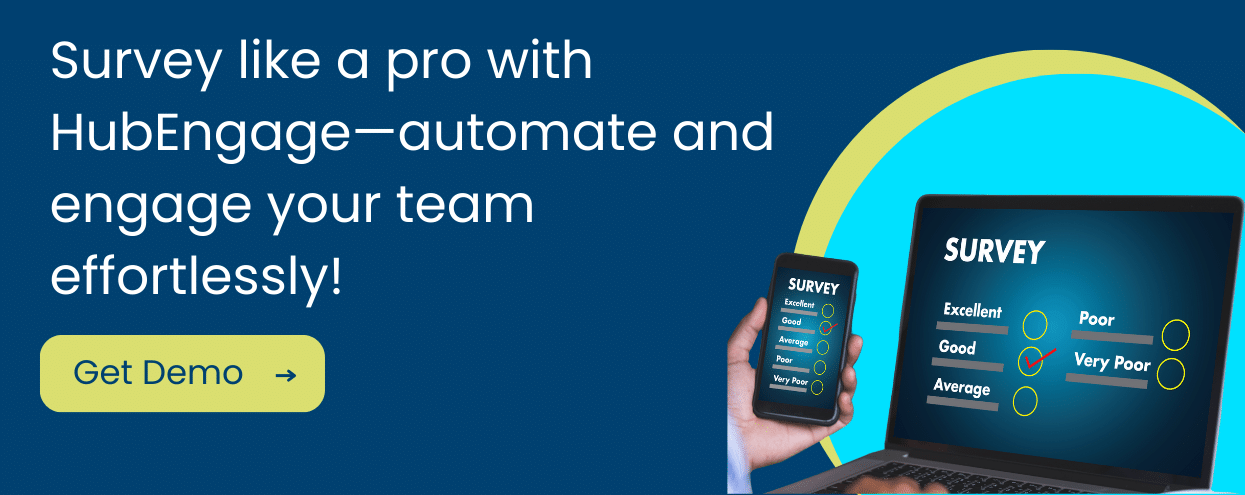Employee recognition surveys are the heartbeat of a vibrant workplace culture. They’re a powerful tool that fuels motivation, encourages efficiency, and fosters loyalty among your team. But how do you ensure your recognition efforts hit the mark every time? The answer lies in crafting a survey that resonates with both employees and HR managers (HRMs).
In this blog, we’ll delve into the art of creating a recognition survey that aligns with the needs of HRMs and cultivates a culture of appreciation. If you are an HRM, you can also check out the ready-to-use survey templates. Click on the in-links to explore.

Employee Recognition Survey Questionnaire: A Shared Responsibility
Effective employee recognition goes beyond a pat on the back. It’s a strategic endeavor that involves HRMs, team leaders, and employees alike. A survey serves as the compass guiding these efforts, ensuring that recognition is meaningful, consistent, and tailored to individual preferences.
From an HR perspective, recognition acts as a powerful adhesive that binds teams, transcends hierarchies, and nurtures a vibrant company culture.
Through tailored recognition initiatives, HR crafts a symphony of appreciation that resonates across diverse talents and backgrounds. Whether it’s public acclaim or a simple note of gratitude, HR orchestrates moments that inspire, motivate, and amplify our shared dedication. That’s why an employee recognition survey is critical.
An employee survey is the nourishment for our professional growth. It inspires us to explore our potential, take risks, and innovate, knowing that our efforts will be acknowledged and applauded. It’s the catalyst that propels us to evolve and thrive in our roles.
Beyond tangible rewards, employee recognition is an intangible currency that enriches our sense of belonging. It’s a bridge that connects us to our colleagues, forming bonds of camaraderie that transcend tasks and titles. It’s in these connections that the true essence of our work comes alive.
Designing the Perfect Recognition Survey
Crafting a meaningful and effective employee survey requires a thoughtful approach that captures the pulse of your workforce. As organizations increasingly prioritize employee engagement and well-being, designing a survey tailored to recognize and appreciate employees’ contributions becomes an essential endeavor. In this section, we will explore the key elements and strategies that go into designing the perfect staff survey, ensuring that it not only gathers valuable insights but also resonates deeply with your team’s aspirations and accomplishments. Let’s delve into the art and science of creating a survey that celebrates the heart and soul of your workforce.
1. Identifying Key Performance Areas (KPAs) via Staff Recognition Surveys:
Begin by identifying the core competencies and accomplishments that deserve recognition within your organization. Tailor the survey to reflect these areas, ensuring that recognition is aligned with business goals.
Crafting the perfect employee recognition survey necessitates a meticulous alignment with these identified KPAs. Tailoring each question and category to mirror these areas of excellence ensures that the survey resonates authentically with the essence of your organization’s achievements. As employees engage with the survey, they embark on a journey that not only captures their individual accomplishments but also anchors them to the broader tapestry of the company’s aspirations.
This synergy between recognition and business goals amplifies the impact of the survey. It transforms the survey from a mere data-gathering tool into a catalyst for driving performance, fostering innovation, and inspiring a shared commitment toward overarching objectives. By weaving the fabric of the survey with the threads of key performance areas, you create a narrative that encapsulates the heart and soul of your organization’s remarkable journey.
2. Engaging and User-Friendly Interface:
An employee recognition survey should be easy to navigate and visually appealing. Incorporate a mix of checkboxes, open-ended questions, and rating scales to gather diverse insights.
To achieve this, the survey’s design should be a masterpiece of user-friendliness. It’s a canvas where checkboxes, open-ended questions, and rating scales harmoniously coexist, inviting employees to share their thoughts with ease and precision. The checkboxes offer quick yet impactful responses, open-ended questions unravel narratives and insights, while rating scales quantify sentiments in a language of metrics.
Visual appeal dances hand in hand with functionality. Engaging graphics, soothing colors, and intuitive layouts guide respondents through a journey of reflection and expression. This visual symphony isn’t just an aesthetic flourish; it’s a deliberate orchestration to make engagement effortless.
The diverse array of question types enriches the survey’s tapestry, accommodating varied communication styles and preferences. As participants navigate the survey, they’re empowered to articulate their experiences comprehensively. From succinct checkmarks to eloquent prose, every avenue for expression is paved.
3. Balanced Frequency in Your Staff Recognition Survey:
In the delicate choreography of surveys, the concept of balanced frequency takes center stage. Picture it as a rhythmic dance, where the steps are measured, harmonious, and perfectly synchronized.
A well-timed survey, akin to a carefully orchestrated dance routine, is essential to sustain the momentum of consistent recognition. Like clockwork, it arrives at intervals that feel natural and unobtrusive, seamlessly interwoven into the cadence of daily work.
However, balance is the key, as excessive frequency can disrupt harmony. Just as over-rehearsed dance moves can feel forced, an overwhelming stream of surveys risks diminishing the genuine essence of recognition.
A survey’s balanced frequency is about infusing it with purpose. Each survey serves as a meaningful checkpoint, a moment to pause and acknowledge accomplishments. When the rhythm is just right, employees don’t merely participate; they eagerly anticipate and engage, weaving recognition seamlessly into their routine.
4. Peer-to-Peer Recognition Survey:
Imagine your workplace as a garden of collaboration, where every employee is not just a unique flower, but also a keen observer of the beauty around them. Peer-to-peer recognition is like sunlight filtering through the leaves. It nurtures a culture of appreciation that flourishes among colleagues.
By enabling peers to recognize one another, you cultivate a dynamic camaraderie that weaves through the fabric of your organization. It’s an acknowledgment that resonates with authenticity, rooted in firsthand experience and genuine respect. This organic recognition often carries a unique warmth, like a whispered “thank you” that echoes across the office.
This concept, in essence, empowers employees to become recognition ambassadors. It’s a spontaneous, heartfelt exchange of gratitude that transcends hierarchies. Further, as peers recognize each other’s accomplishments, a tapestry of team accomplishments takes shape. It’s like stepping back to admire the entire garden, where individual blooms collectively create a breathtaking landscape.
Peer-to-peer or staff recognition survey goes beyond a mere transaction; it becomes a way of life. It thrives in spontaneous interactions, from congratulatory emails to appreciative nods in meetings. It nurtures a culture where every effort is seen, every contribution is valued, and every voice is heard.
HRM-Centric Elements: Catering to HR Managers
1. Analytics and Reporting of Your Staff Recognition Survey:
Equip HRMs with insightful data through robust analytics and reporting features. Highlight trends, popular recognition categories, and outstanding performers.
Foremost, comprehensive analytics grant you a panoramic view of your survey results. From response rates to trend analysis, these tools distill complex data into actionable information, empowering you to make informed decisions with confidence.
Real-time tracking in staff recognition surveys is another invaluable asset. With live dashboards, you can monitor survey progress as it unfolds, enabling swift adjustments if needed and facilitating agile decision-making.
In-depth reporting transforms raw data into compelling narratives. Visualization tools, such as graphs and charts, paint a vivid picture that’s easy to comprehend, facilitating effective communication of findings to stakeholders.
Furthermore, survey analytics uncover patterns and correlations that might otherwise remain hidden. This deeper understanding allows you to identify opportunities for improvement, optimize strategies, and craft tailored interventions.
Segmentation capabilities within analytics offer a personalized lens. You can dissect data based on demographics, roles, or responses, enabling targeted insights that cater to specific audience needs.
Predictive analytics in employee recognition surveys add a forward-looking dimension. By extrapolating trends, you can anticipate future scenarios and proactively shape strategies that align with evolving expectations.
The ability to export and share reports enhances collaboration. Whether it’s presentations to management or data sharing with colleagues, robust reporting functionality ensures seamless knowledge dissemination.
Ultimately, survey platforms with analytics and reporting functionalities extend far beyond data collection—they empower you to extract meaningful intelligence. This insight-driven approach fuels evidence-based decisions, fuels organizational progress, and guides you on a journey of continuous improvement.
2. Customizable Employee Recognition Survey Templates:
Provide HRMs with pre-designed recognition templates that can be easily customized to suit specific occasions or events.
Firstly, customizable templates save precious time and effort. They provide a foundation upon which you can build your survey, eliminating the need to start from scratch. This efficiency allows you to focus on refining survey questions and objectives, enhancing the quality of the data collected.
Moreover, customization ensures alignment with your organization’s branding and communication style. The templates can be personalized with logos, colors, and fonts, presenting a cohesive and professional image that resonates with participants.
Customizable staff recognition survey templates also promote consistency and standardization. Whether you’re running multiple surveys across departments or over time, templates help maintain a uniform structure, simplifying data comparison and analysis.
Innovation is another key benefit. Templates serve as creative springboards, sparking ideas for unique survey designs and approaches. By customizing templates, you can experiment with various question formats, layouts, and engagement strategies to optimize participant response rates.
Lastly, customization caters to diverse survey objectives. Whether you’re conducting employee engagement assessments, customer feedback evaluations, or market research, customizable templates can be adapted to suit different purposes, ensuring relevance and effectiveness.
3. Integrating Staff Recognition Surveys with Performance Appraisal:
Seamlessly integrate recognition data with the performance appraisal process. This synergy reinforces the value of recognition within the organization.
Employee feedback gathered through surveys seamlessly feeds into the performance appraisal system, providing a comprehensive and well-rounded perspective on individual contributions and potential areas of improvement.
Enhanced accuracy in your employee recognition survey is another significant advantage. The integration minimizes manual data entry, reducing the chances of errors and ensuring that appraisal information is up-to-date and reliable.
Moreover, the fusion of survey and appraisal platforms facilitates continuous feedback loops. Employees receive real-time insights through surveys, enabling them to make proactive adjustments and align their efforts with performance expectations.
This collaboration enriches the appraisal process with qualitative context. Staff recognition survey responses offer narratives that paint a holistic picture of an employee’s strengths, challenges, and achievements, augmenting the quantitative metrics traditionally used in appraisals.
Efficiency gains are substantial. The time saved in data collation and cross-referencing allows HR professionals and managers to focus on meaningful discussions, goal-setting, and developmental planning during performance review conversations.
Furthermore, the integration empowers employees with ownership of their development journey. Insights from surveys contribute to personalized growth plans, fostering a sense of empowerment and commitment to continuous improvement.
Strategically, the combined data provides a valuable resource for talent management. It informs succession planning, training initiatives, and strategic workforce decisions based on the collective intelligence gathered.
The Employee Recognition Experience: What Matters Most
1. Personalization:
Tailor employee recognition survey options to match employees’ preferences. A personalized touch ensures that recognition is meaningful and authentic. Personalization also fosters a sense of relevance. Customized surveys address specific roles, departments, or experiences, ensuring that each participant engages with questions that directly relate to their responsibilities and perspectives.
The feeling of being heard is amplified. Tailored surveys communicate that the organization values each employee’s input, which in turn encourages candid and authentic responses, contributing to more accurate and insightful data.
Personalization extends to staff recognition survey formats. Offering a variety of question types allows respondents to express themselves in ways that mirror their communication styles, making the survey-taking experience more intuitive and comfortable.
The data gleaned from personalized surveys provides insights that matter. By understanding unique challenges, preferences, and needs, organizations can craft targeted interventions, refine policies, and design development programs that directly address individual concerns.
Furthermore, personalization enhances the journey of change. Employees appreciate when survey results lead to tangible improvements that directly impact their day-to-day experiences, leading to increased trust and confidence in the organization’s commitment to their well-being.
In a broader sense, employee recognition surveys contribute to a culture of inclusivity. By acknowledging individual voices, organizations create a rich mosaic of perspectives, ultimately fostering a more diverse and harmonious workplace environment.
Ultimately, a survey platform that embraces personalization as a core value places employees at the center of the survey experience. This approach empowers them to contribute meaningfully, facilitates actionable insights, and strengthens the bond between employees and the organization, fostering a collaborative journey towards shared success.
2. Timely and Immediate:
A survey platform that prioritizes timeliness and immediateness offers employees a real-time avenue for expressing their thoughts, opinions, and feedback. Enable real-time recognition to capture achievements as they happen. Swift acknowledgment magnifies its impact.
Firstly, timeliness fosters relevance. Staff recognition surveys delivered at the right moment capture employees’ experiences and sentiments while they are fresh, ensuring that their responses accurately reflect current situations and emotions.
The element of immediateness fuels a sense of urgency. When employees are invited to share their input promptly, it signals that their perspectives are crucial and can influence immediate decisions and actions.
Responsive surveys empower employees. They can swiftly voice concerns, celebrate successes, or suggest improvements, knowing that their feedback will be acknowledged promptly and potentially lead to rapid change.
Real-time survey results enable transparency. When employees see their feedback swiftly transformed into actionable insights, it reinforces the organization’s commitment to openness and its willingness to listen and adapt.
Moreover, timeliness creates a dynamic feedback loop. Immediate employee recognition survey responses can trigger follow-up actions, initiatives, or discussions that address emerging issues or capitalize on timely opportunities.
For employees, timely surveys show that their voices matter here and now. It highlights their sense of ownership, engagement, and connection to the organization.
In a broader context, a survey platform emphasizing timeliness and immediateness contributes to a culture of agility. By enabling rapid data collection and response, organizations demonstrate their ability to pivot, evolve, and align with the ever-changing needs of their workforce.
Ultimately, a survey platform that embraces timeliness and immediateness places the pulse of the organization in the hands of its employees. This approach empowers them to actively contribute to real-time conversations, enriches decision-making processes, and solidifies the organization’s commitment to fostering a responsive and engaged work environment.
3. Open Feedback Channels:
A survey platform that champions open feedback channels provides employees with an invaluable avenue to express their thoughts, ideas, and concerns. This yields a range of benefits that amplify engagement, trust, and the overall impact of the survey process.
- Staff recognition surveys as open feedback channels foster transparency. Employees appreciate the opportunity to share their opinions directly with the organization’s leadership.
- It creates a culture of honesty and openness.
- When employees know that their feedback is not only welcomed but also actively sought, it encourages them to participate, knowing their voices will be heard.
- Avenues for open feedback empower employees to contribute to the decision-making processes.
- Employee recognition survey gives them a sense of ownership and influence over the company’s direction.
- Employees value being part of a two-way conversation. Open feedback channels allow them to share their insights and simultaneously receive responses and updates from the organization.
- Moreover, open feedback sparks innovation. It creates a fertile ground for creativity, problem-solving, and continuous improvement.
- For employees, open feedback channels signal that their perspectives matter and are integral to the organization’s growth. This recognition bolsters their sense of belonging and encourages active participation.
- In a broader context, open feedback channels contribute to a culture of collaboration and let you effortlessly do a survey for employee retention.
- By fostering open dialogue, organizations harness the collective intelligence of their workforce, leading to better decision-making and solutions.
Ultimately, a survey platform that champions open feedback channels places employees at the heart of organizational evolution. This approach empowers them to actively contribute, cultivates trust and transparency, and cements the organization’s commitment to creating an environment where every voice is valued and heard.
Conclusion: HubEngage Employee Recognition Surveys Work for Every HRM
An effective survey bridges the gap between HRMs and employees, fostering a culture of appreciation that transcends hierarchy. By crafting a survey that captures the essence of your organization’s values, you’ll unlock the full potential of recognition as a tool for motivation, engagement, and positive workplace dynamics. Whether you’re a seasoned HRM or just starting out, a recognition survey that works for every HRM paves the way for a workforce that feels valued, inspired, and committed to your shared success.
HubEngage provides over 3 dozen ready-to-use survey templates that you can use with or without any edits. Access here, the employee recognition preferences questionnaire template that works for all.













